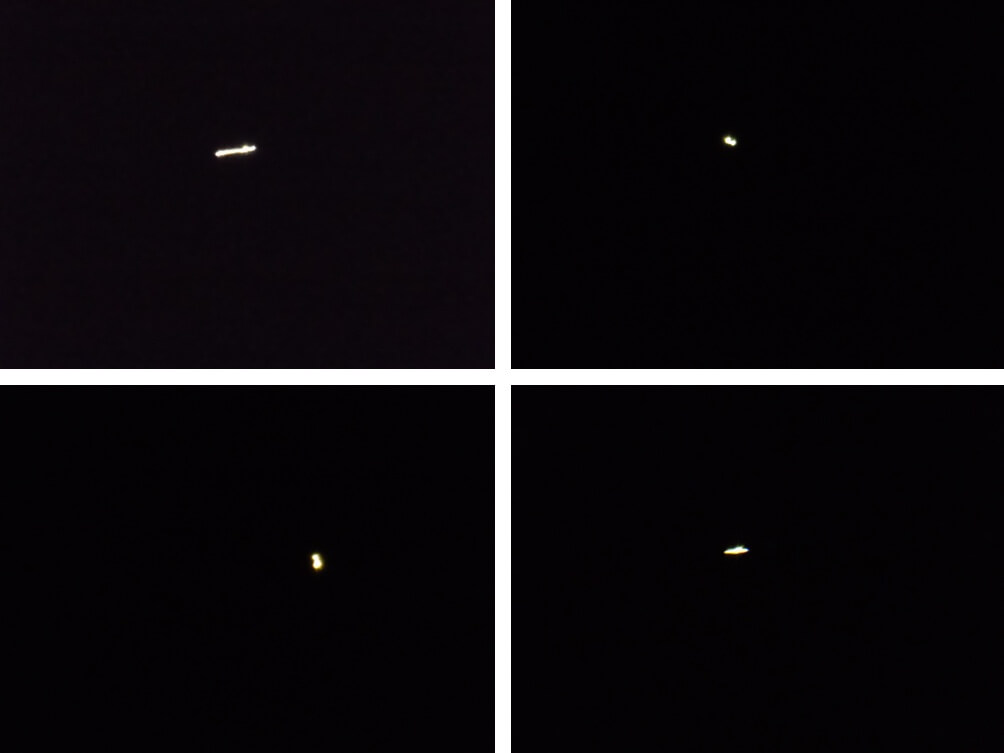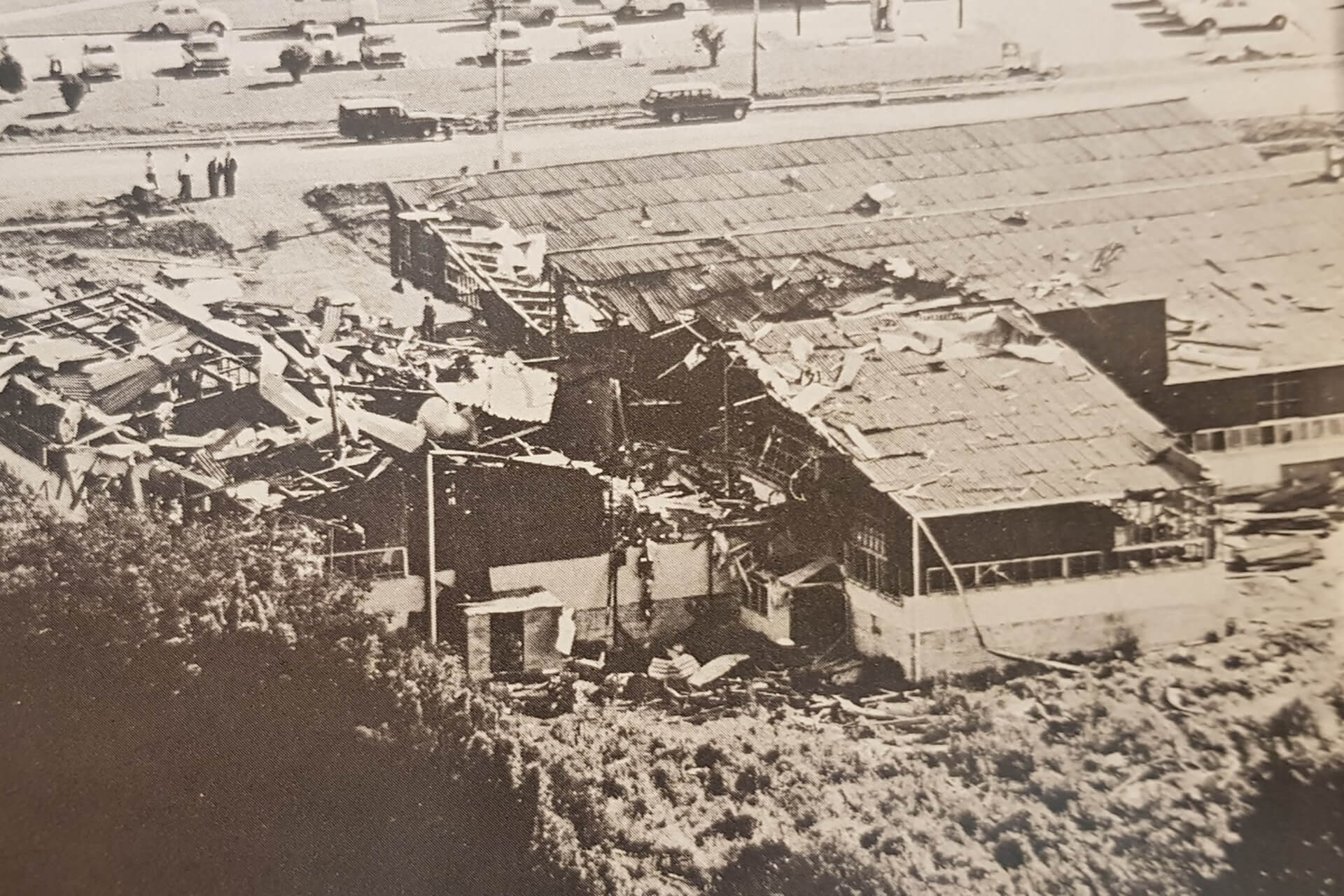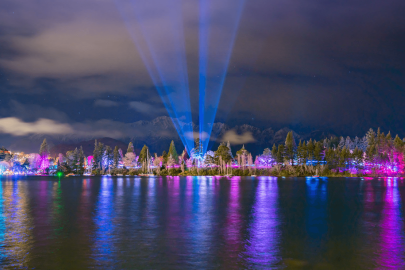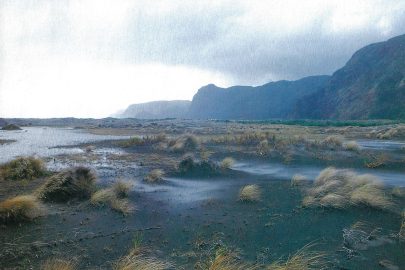Mar 13, 2022 City Life
At 3am on 23 September 1966, a clear cold winter’s night, Auckland was rocked by a massive explosion heard from Waiuku to Warkworth. The ground trembled and Aucklanders in pyjamas leapt from their beds terrified that Rangitoto had finally burst into life, or that Taupō had decided to blow the centre of New Zealand to smithereens.
The explosion, as it turned out, was centred on Rosebank Rd in Avondale, in a factory where the company F. and W. Fowler electroplated car parts. The building was totally wrecked, as were surrounding houses. Every window within half a mile had blown out. Steel beams of the foundry were reshaped, the roof was torn off, and concrete blocks from the walls were hurled into residential gardens. Across the road, the Reckitt & Colman factory’s 223 windows were blown in. Nearby houses were lifted off their foundations, roofs were cracked, and bricks and broken glass were strewn all over Rosebank Rd. The Fire Brigade, police and the company’s owners arrived quickly to assess the damage and to try to fathom out what could have caused such a gigantic blast.
Up on the summit of Mt Albert, my friend the late Ian Smith and his girlfriend were spending a few private moments in the car park when they chanced to gaze west and saw a beam of bright light descend from the sky over Avondale. This light was also observed by residents living near the Fowler foundry, and some said it had been preceded by an audible hum that woke up households in the area and set dogs barking.
The next night, Smithy and I talked about what had occurred while enjoying a beer at the Queen’s Ferry hotel in the CBD. He’d been shaken by the experience. The owners of F. and W. Fowler invited the media in the next day, showing them the electroplating unit that had been the scene of the explosion. But when the concrete bath was removed, beneath it was a crater and a hole that seemed to be metres deep. The media interest, though, soon petered out and the matter simply went unexplained.
One man was not surprised by the events, though. His name was Bruce Cathie, a captain with National Airways Corporation (NAC), the domestic airline that would later amalgamate with Air New Zealand. This was the break-through that Cathie knew would come. I decided that Smithy and I would call in on Cathie, who I knew had been interested in the phenomenon of UFOs in New Zealand. We met on a Saturday morning soon after the Rosebank Rd blast and I came to regard him as a mathematical genius and one of the most creative minds I had ever met. We became friends and remained so until his death in 2013.
Cathie told Smithy and me of two sightings which he claimed were characteristic of a “presence” that we needed to be aware of. He said he’d experienced the first with six companions outside an aero club at Ardmore Airfield, and it had set him off on a lifetime of investigation and discovery. As he spoke, he was surrounded by a room full of folders, charts and research files. He’d interviewed many people who had seen strange objects in the sky. Auckland, he said, was a node on an electromagnetic grid.
Two weeks after the Rosebank Rd explosion, a TV news crew from the New Zealand Broadcasting Corporation visited a farmer in Pukekohe who had found a perfectly formed hole about 20cm in diameter behind his cow shed. He had lowered a plumb bob into it and when it reached 20m, he gave up. It looked just like the hole under the electroplating bath at the Fowler foundry.
Cathie, who was a serious researcher and not regarded as part of a lunatic fringe of UFO spotters, had a mind-bending experience while flying a Fokker F27 Friendship from Whenuapai, then Auckland’s main airport, to Kaitaia on 12 March 1965. The weather was perfect, so he decided to fly along the west coast. As he approached the southern end of Kaipara Harbour, he looked down and saw a large whale, which he took to be stranded in the shallow receding waters. He was making good time, so he and his co-pilot decided to take a closer look. As he turned the plane, his hair stood on end. Below him was not a whale but a large metal triangular shape that he
said could only be described as an underwater machine. He took it to be 100 feet long, with a diameter of 15 feet at its widest point. “I couldn’t believe what I was seeing,” Cathie told me later. He believed he had seen a spaceship. It was a defining moment, setting him on a lifelong path of semi-scientific work on unidentified flying objects.
Cathie started recording the coordinates of locations where unexplained phenomena had been seen, and within two years he had established a map with points marked in a grid across Auckland and the rest of the country. So what were these mysterious shapes flying around the Tāmaki Isthmus? I would visit Cathie periodically and was fascinated by the growing number of reports from people sighting strange things over Rangitoto, Waiheke and Māngere, all following his grid. He believed we were not dealing with things from another planet but, rather, that the mysterious objects were moving in and out of time zones through portals based underground or underwater. Cathie’s mathematical studies led him to consider Lake Pupuke as a possible UFO vent and a major grid focus point, which he found fascinating in its origins and deep unknown depths. He considered it vital in the Auckland grid pattern.
In 1968, residents around Takapuna, Rothesay Bay and Campbells Bay started complaining about a deep hum. Initially, reports came in only infrequently, with just a few complaints to local councils, but in the 1970s, they grew in number when people across the North Shore would wake up and hear a deep reverberating sound coming from the ground beneath their houses. In 2008, Tom Moir and Fakhrul Alam at Massey University Albany were asked to investigate and found a 56Hz hum — inaudible to most people — in pockets of the Shore. It would keep some people awake at night, or drive them crazy during the day. One resident told One News in 2011 that it sounded “like a propeller aeroplane in the distance”. Two years later, another resident described it to Tristram Clayton on Campbell Live as “like a diesel engine”. Said another: “It’s not loud but it’s penetrating.” One woman played a YouTube video of the cabin noise of a 747 to drown out the noise. George Wood, the former Mayor of North Shore, and Julia Parfitt, who had been the deputy mayor, provided me with countless emails and reports that they had considered over the years. The North Shore Hum continues today unabated. Cathie was adamant it was related in some way to the Auckland UFO sightings.
On 21 December 1978, strange things were seen in the night sky over Kaikōura. The crew of a Safe Air cargo plane reported bright lights from an unknown object travelling alongside them as they flew from Blenheim to Christchurch. They continued for 10 minutes or more. Nine days later, an Australian-commissioned television crew flew on another Safe Air plane between Wellington and Christchurch. Shortly after takeoff, the pilots noticed strange lights appearing and disappearing over the Kaikōura coastline. The captain shouted to the newsmen to get into the cockpit immediately. The cameraman captured film of a rapidly moving bright white light. At Christchurch, the terrified TV sound operator refused to reboard the plane for the return flight to Blenheim, but her colleagues did. Again, they filmed the bright lights. Their coverage became a global sensation, making headlines around the world, but sceptics passed the lights off as be- ing from the large foreign fishing fleet below and reflecting off clouds. This reaction ignored the fact that the unex- plained lights were recorded by airport radar in Wellington and Christchurch. Days later, the New Zealand Herald reported that another television crew, sent to the Clar- ence River in the Kaikōura region, had ”filmed a brightly lit object from 3.15am until after dawn”.
The Kaikōura lights footage remains one of the world’s most amazing visual evidence of something totally inexplicable. The Royal New Zealand Air Force has these recordings and many more taken between 1977 and 1982, but although it released some of its reports in 2015 under the Official Information Act, it refused to comment. Before the release, spokesman Squadron Leader Kavae Tamariki said the Defence Force did not investigate UFO sightings and would not comment on the contents of the files. “We’ve just been a collection point for the information,” he told the Dominion Post. “We don’t investigate or make reports; we haven’t substantiated anything in them.” The remaining files remain under lock and key in New Zealand’s national archives, where they’ll remain sealed until 2080.
In 2017, a United States Central Intelligence Agency report on the sightings was declassified. It read: “The New Zealand UFO sightings of December 31, 1978, are unique among civilian UFO reports because there is a large amount of documentary evidence which includes the recollections of seven witnesses, two tape recordings made during the sightings, the detection of some unusual ground and airplane radar targets, and a 16mm colour movie.”
And so we inch closer to finding out what’s really out there, if anything. On 22 December, Nasa, the European Space Agency and the Canadian Space Agency are scheduled to launch the mammoth James Webb Space Telescope. It’s taken 25 years and US$10 billion to plan and create. It weighs 6.5 tonnes, and when it is sent into orbit on the back of a European rocket with the glorious name Ariane 5 – after a princess in Greek mythology – it will journey for 29 days to its planned orbit, which at times will have it flying 1.5 million kilometres from Earth. Although we will never be able to step on the telescope, it will be forever in communication with us. We on Earth may be able to spot it as a far-off star. It’s a glorious creature. It has magnificent wing-like foil sheets, each as large as a full-sized tennis court, and will unfold like a giant space umbrella. But its magic is that it will look at the universe and at galaxies formed a billion years ago. That’s a serious ambition to be able to see back through light, travel and time and to record the beginnings of the Big Bang and, more importantly, to hopefully throw light on who and what is out there.

Photographs in sequence, taken by Robin Kewell, September 17, 2021, approximately 7.25pm, Oratia.
While I was writing this story, my good friend Robin Kewell, a film director and producer, told me that two nights before, in the middle of lockdown, he had been out on his deck in Oratia late at night and was stunned by an extraordinary sight that appeared out of the blue over the Waitākere Ranges. A bright object emitting changing colours moved slowly, then vanished, but not before he had pulled out his phone and taken a series of images. They fit all the images that I’ve seen over the years that were collected by Cathie as he diligently followed up both sightings and stories. Rich and true and still unexplained.
New Zealand has amassed hundreds of such reports. They are contained in a 2000-page file locked in our national archives. These have come from the general public, sky-watchers, and military and commercial pilots. When asked, the Defence Force’s spokesman simply refused to respond to all the UFO sightings in New Zealand with anything other than a brief “no comment”. Yet this year, the US State Department declassified its report into sightings of unexplained phenomena. It listed examples from all over America, both on land and sea. While the report stated that many investigations into UFO crashes were fake — like that grand hoax, the 1947 Roswell crash in New Mexico of a supposed alien spacecraft — it conceded there were many instances that could not be explained. The US government, according to the report, did not deny the possibility of the existence of UFOs, but it didn’t have evidence of their existence, either.
Yet, the sightings continue unabated. This Christmas, we may see the most outstanding film on the subject yet — The Phenomenon, which New York researcher and investigative journalist Leslie Kean says will include amazing new footage sharp and clear — something always missing — and possible answers to just where the UFOs are coming from. Let me beat Leslie to it. After half a lifetime of reading and watching, I take Sherlock Holmes’ advice: “When you have eliminated the impossible, whatever remains, however improbable, must be the truth.”
–






